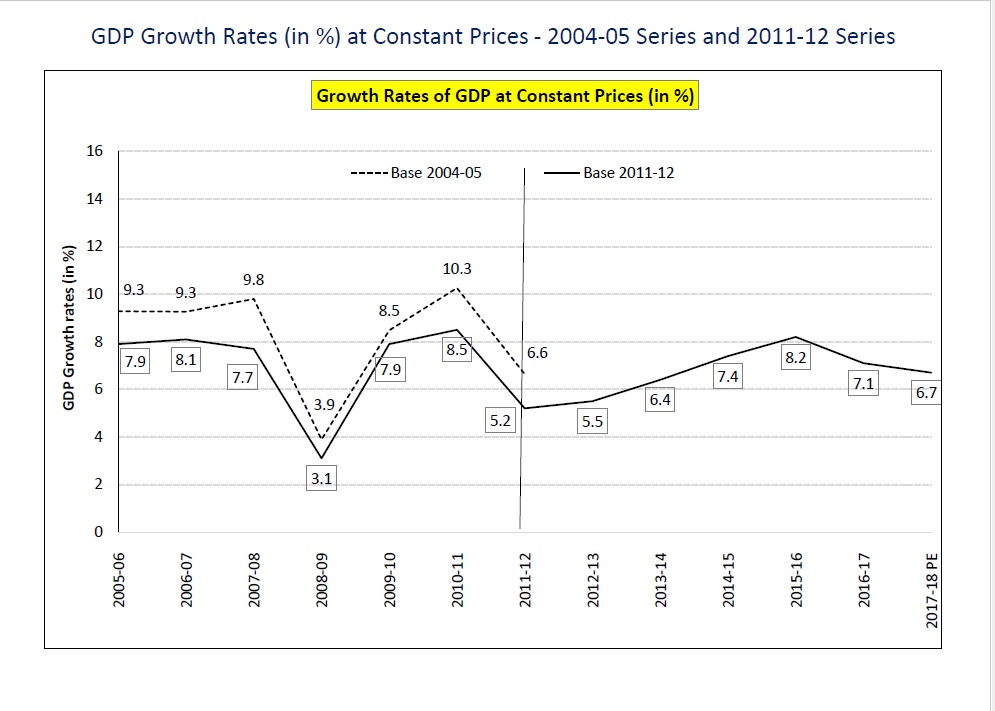
In his own strident way, never giving an inch and always straining to milk dry the argument for his side, Finance Minister Arun Jaitley has summed up the frivolousness of the debate on GDP growth rates. The Minister wrote in his blog: “Data based on facts and on the best global practices is rejected by the (Congress) party because it takes away the last of its surviving arguments (that) ‘my GDP growth was higher than yours’.” The words are delightfully ironic in the way they capture the emptiness of numbers, growth and all that is measured and taken as delivered to the people of India. Here is the brutal truth from the Finance Minister, presented in a lawyerly flow: it is my GDP versus yours. What, one might pause to ask, about the people for whom the GDP is meant to work?
The new series in effect reduces the growth numbers during UPA-I and UPA-II, causing an uproar from the Congress. For example, the new data shows the average economic growth between 2006-07 and 2013-14, the UPA-I and UPA-II years, was 6.7 per cent, lower than the average economic growth of 7.4 per cent between 2014-15 and 2017-18, the BJP years. Thus comes the argument, “my GDP” is better than “yours”!
This is the inevitable direction policy makers fall to when the idea of growth and development is reduced to the numbers on a series. The debate that then takes hold is about the integrity or lack thereof not of the decisions and the direction of the nation but of the calculations, techniques and methodologies. It’s just the place for economists to rule the roost, for the establishment to flex its muscles, even for the Opposition to make its counter but for the people to exit the debate.

This time, it’s about the “new series” of national accounts and growth numbers introduced in January 2015, which changed the base year to 2011-12 from what was earlier 2004-2005. Data since then has followed the 2011-12 base but was not comparable to previous data since that was calculated using a different base year. On November 28, the Central Statistics Office in the Ministry of Statistics & Programme Implementation issued the back data with the new base year, a fairly complex exercise in which arguments can be buttressed by sides who agree with the fine print of the methodology and those who don’t. The new series in effect reduces the growth numbers during UPA-I and UPA-II, causing an uproar from the Congress. For example, the new data shows the average economic growth between 2006-07 and 2013-14, the UPA-I and UPA-II years, was 6.7 per cent, lower than the average economic growth of 7.4 per cent between 2014-15 and 2017-18, the BJP years. Thus comes the argument, “my GDP” is better than “yours”! The new data tells us that the UPA never clocked double digit growth. In 2010-11, when it reported 10.3 per cent, the new data records it at 8.5 per cent. In fact, the new series claims the UPA never touched 9 per cent GDP growth either.
When diversity is derided, not respected, when India’s multi-cultural ethos is under attack and when what we eat, how we worship and what faith we follow is the cause of divisions, then it will not be long before the stresses and strains travel to the economy.
Beyond a point, the exercise is meaningless. It may help the BJP, but only to the extent that the party can free itself from the electoral perils of demonetisation, which is now largely accepted as a disaster in terms of sucking out growth and what it did to ordinary citizens while allowing those up the economic and social ladder to get away with little trouble. What the new series cannot and does not change is that growth did accelerate during the Dr. Manmohan Singh era, and that the Indian economic engine continues to run at a pace that the liberalised Indian economy has settled into – which is 6 to 7 per cent. We are nowhere near being a double-digit growth economy, and this is a fair assessment of the Indian journey.
Beyond this, the numbers don’t help frame the debate of how India should chart its growth journey. Growth cannot be only about projects, factories, new services and the infrastructure required to house and run this activity, though these are vital components. What also matters is whether the new India offers opportunities for people with new ideas to set up new and innovative businesses and services and if the nation can encourage, nurture and support a fair, transparent and reasonably efficient eco system for this. This inevitably means simpler laws, corruption-free regulation and weeding out the rampant rent seekers who crowd the Indian landscape. Since economic activity cannot go on in a vacuum, it also means a social fabric that enables people to work across States, languages, cultures, religions and castes. Economic activity cannot be high when social tensions are high. Which means that the politics of the day will influence the growth agenda of the day.
Growth cannot be only about projects, factories, new services and the infrastructure required to house and run this activity, though these are vital components. What also matters is whether the new India offers opportunities for people with new ideas to set up new and innovative businesses and services and if the nation can encourage, nurture and support a fair, transparent and reasonably efficient eco system for this.
If it is prohibitive to set up a business because entrenched interests hold on to their privileges, if the cost of entry is kept artificially high, then businesses cannot start or operate efficiently. Equally, if communal tensions are high, the conversation is almost always about “us” versus “them” and the metaphor is war, then talent cannot work let alone thrive. When diversity is derided, not respected, when India’s multi-cultural ethos is under attack and when what we eat, how we worship and what faith we follow is the cause of divisions, then it will not be long before the stresses and strains travel to the economy. Whatever the numbers tell, in all of this, the BJP has not delivered higher growth and on that there can be little doubt.
This takes the nation and the debate on the nature of our growth story several steps backward. Balance, harmony and mutual respect become the ask, whereas that ought to be a given, and then we can argue that the Congress model of growth itself was none too robust. For example, monumental and unchecked corruption, disdain for the environment, the plunder of mineral and other resources of the commons to benefit a handful and the NPAs of today all add to growth numbers but do not take the economy any further on the path of growth for the people.
If we want sustainable economic growth for the everyday citizens of India, it means first understanding the word “economics”, which comes from the Greek word oikos (meaning a family unit), which originated as a form of “household management”. And it should be common sense that a household under which some thrive while others don’t will not remain together for long.
(The writer is a journalist and a faculty member at SPJIMR. Views are personal)



